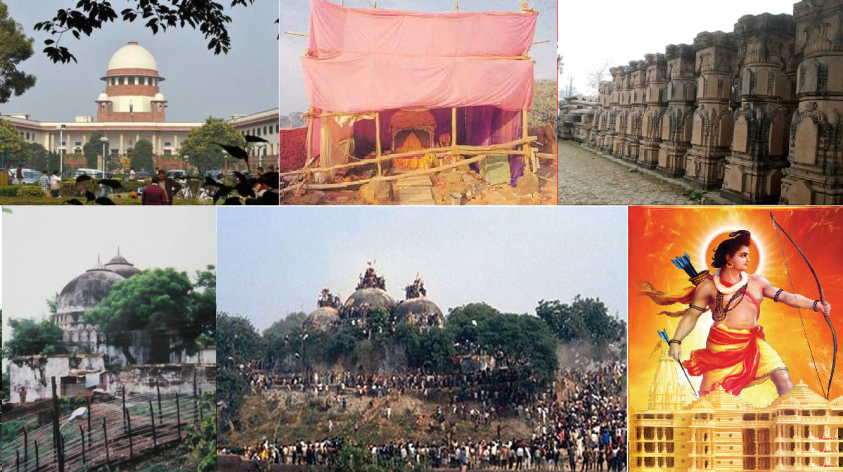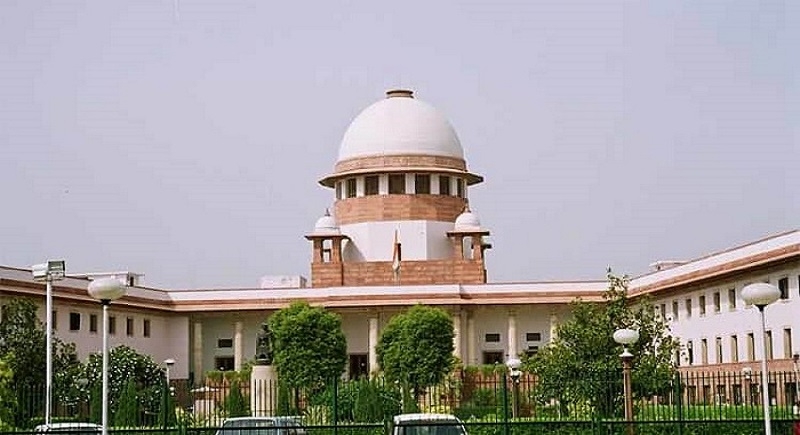Responsibility for Ram Mandir controversy

Different stages of Ramjanmabhumi agitation
Next in the firing line are the main right wing political parties – BJP, Shiv Sena etc. Rarely ever they criticize the diabolical role played by Sunni and Shia Muslim political parties alongside the pseudo secular parties led by the Congress Party.
Hardly ever the procrastinating and prevaricating role played by the judiciary gets highlighted. Add to this, media as the manipulator behind the scenes shaping people’s perceptions as the problem.
Let me recall the irrefutable fact of the three-judge Supreme Court bench hearing of the Babri Masjid’s case - ten times - what with the recent one in July 2018. Yet, it struggled to decide if the matter should be referred to a constitution bench of five or more judges instead of as an ordinary title dispute.
Why the exception by the Supreme Court in the Ram Mandir issue? After all, in recent times, the Supreme Court constitution benches have adjudicated highly emotive and sensitive cases like instant triple talaq, passive euthanasia, Delhi statehood case, Sabarimala temple entry ban case and Parsi ex-communication case. So its dilly-dallying or hesitation in referring the issue to the constitution bench (Article 145(3) of the constitution mandates any case involving a substantial question of law relating to constitutional interpretation) is quite inexplicable.
It is high time “Judiciary” practices what it preaches and must uphold: “Justice delayed is Justice denied”.
Is the Supreme Court culpable of indulging in “passing the buck” game to political leadership only to be followed by passing strictures and finding faults against any political decision?
Even the partisan media is also part of the problem complexity. Some of them are culpable of not sharing ‘facts’ of the dispute accurately to people. To compound the issue, media indulged in speculation over “issue of Ordinance” or “Tabling of Law” in the Lok Sabha as a political imperative or compulsion of Modi led BJP/NDA.
Facts of Babri Masjid are available in public domain. Neither Babur nor his General Mir Baqi constructed the Masjid as per the Archeological evidence. Babur Nama, an authentic record of events of Babur, does not mention the name of Ayodhya or a visit to such a name place.
Stating the obvious, the Babri Masjid at Ayodhya was demolished on 6 December 1992 familiarly referred in the media as the “Black Sunday.” Media publicized it and blamed communalists on either side besides the politicians. The government started rolling heads – bureaucrats at local and State level were changed. Judiciary remained a silent spectator.
Let me recount the findings of the Archeological Survey of India (ASI) ordered by the Allahabad High Court after a lapse of over a decade in March 5, 2003, to excavate the disputed site in order to determine whether a temple existed where the mosque stood. The ASI found features of 10th Century temple and submitted its report to the Allahabad High Court in August 2003.

Quite prophetic is the reflection of K N Panikar, Professor of Modern History, JNU, who stated after the Babri Masjid demolitions: “While the partition was culmination of the communal movement, Ayodhya is not necessarily the end. It might well be the beginning of a major political catastrophe”.
Next, the legal battles to include: filing of suits in 1950 by Mahant Paramhans Ramchandra Das and Gopal Singh in Faizabad, and puja allowed; 1959: filing of cases in 1959 by Nirmohi Akhara and others seeking permission to conduct prayers; filing of case in 1961 by Sunni Central Board of Waqfs in UP claiming the mosque; and, Faizabad District Judge orders to open the gates for Hindus to offer prayers in 1986 followed by formation of Babri Action Committee and shifting the case to the High Court.
Also, on All India Muslim Personal Law Board challenging the ASI report, the High Court reserved its judgment and advised all parties to solve the issue amicably in July 26, 2010. In September 23, the plea for an out-of-court settlement reached Supreme Court and the apex body said it would hear it again on September 28. Subsequently, the High Court announced to pronounce the verdict on September 24, but deferred the judgment on a writ petition that was rejected later. However, the apex court rejected petition for deferment and gave the nod to the Allahabad High court to deliver the judgment.
The Allahabad High Court pronounced its verdict on September 30, 2010 and ruled for a three-way division of the disputed area, between the Sunni Waqf Board, the Nirmohi Akhara and the party for ‘Ram Lalla’.
In February 26, 2016, the Supreme Court permitted BJP leader Subramanian Swamy to intervene in the pending matters relating to the Ayodhya dispute with his plea seeking construction of Ram temple at the site of the demolished disputed structure.
Yet another issue making rounds quite often is forging “amicable out of court settlement” between the two parties in the court case, which has also defied problem resolution.
In sum, the communal conflict in Ayodhya needs to be viewed from historical, social, judicial and political factors. Certainly, it cannot be viewed from the prism of post independence RSS-BJP inspired political problem. After all, communal violence has been recurring feature over nearly the past 170 years and more.
Nehru and Rajiv Gandhi too had favored Hindu point of view by their actions in 1949 (idols of Lord Ram appeared inside the mosque, and both sides filed cases. The government declared the site as disputed and locked the gates to it and 1989 Rajiv Gandhi allowed shilanyas. Even the legal battles have been ongoing over the past 68 years.
Next, social dimension, particularly Hindus hurt psyche, must be appreciated in historical context. Historic-analytically, the theory of waning Hinduism is real. It is under a virtual siege on its own soil. From the dizzy heights of nearly 50% of World population in 001 AD, its slide to 14% is real today. Any visionary Hindu should be able to see the writing on the wall clearly – the dooms day for the Hinduism is not too far off, if pseudo-secularism is persisted with the monotonous consistency of “Gabardine Swine”. It is the last of ancient religions. It has every reason and right to protect its own interests on its own soil.
Today, the Hindu feels belittled, betrayed and embittered in the international environment. They must not, therefore, further compound the hurt psyche of the Hindu. He feels unwanted and despised even in USA today what with Trumps “White Supremacist” upsurge. They must also realize that the Hindu philosophy is based on the invocation of Dharm Yudh or righteous battle. Driven psychologically to the brink of despair, the Hindu polarization, mobilization and consolidation processes may only hasten-up. In my perception, the process of consolidation will become irreversible in the face of continued affronts and threats to their status and survival. As per M N Buch, the Hindu psyche is deeply wounded and those who try to hurt it more, because, to them, secularism means an anti-Hindu stance will, in fact, strengthen those very communal forces who foresee the national flag as having only one color – “Saffron”.
Let me reiterate with all conviction that the secular option or bogey is a mere illusion or mirage or unachievable in our emerging demographics conundrum what with Muslim population surge in highly strategic sensitive borders. Yet another vital issue which needs to be correctly understood is the façade or double face of a majority of the Hindus. Many of them claim outwardly to be secularists, but sub consciously support and stand of radical Hindus. What they fail to understand is that by double standards, they are only further consolidating Pan-Islamic fundamentalism detrimental to the Hindus.
To sum up, both communities thrive on strong complexes rooted in history. If Muslim communalists specialized in raising the bogey of Islam in danger in the past, now the Hindu communalists are raising a similar bogey of Hinduism in danger.
Viewed in the current overall framework of international geopolitics, the hypocrisy of international community gets exposed. For Mark Tully or the BBC or international community, the Hindus concern to protect their own interests and live with dignity, honor and respect on their own native soil may be no consequence. For them, the destruction of Babri Masjid is highly provocative on the part of the Hindus, whereas the destruction of over 40 temples since 1989 in Kashmir valley or the 4th migration of Kashmiri Hindus from the valley failed to bother their conscience. Of course, the destruction of 245 temples in retaliation in Pakistan makes only some news, but not an issue.
Yet another irrefutable fact is the demolition of Masjids for the sake of modernization has been carried out in Islamic countries, such as, Iran, Saudi Arabia and Algiers recently. Even in Karbala, large scale additions and alterations have been carried out to accommodate the Haz pilgrims around the main shrine. So, the hyper-reaction of Indian Muslims, and more significantly the hyper-interventionist role of Pakistan and Bangladesh glaringly reflect nefarious ulterior motives.
Next, the politics over secularism vs. communalism continues to obfuscate realities. What needs to be accepted and must be recognized is that 15 August 1947 was stunning defeat for secularism. Undeniably, the idealist secular Generals lost. They refused to recognize the writing on the wall – if Pakistan was born on the basis of religion, as a corollary, even India too was born on religious basis only. Such is the harsh historical fact and not a mere accident of history. The specter of historic-cultural hatred, distrust and animosity still lurks in the hearts and minds of the majority on all sides.
Yet our secular pseudo secular Generalship persisted with their highly idealistic approach with bullish determination. In their lust for power, their inheritors promoted appeasement of minority communities. And, pseudo-secularism got consolidated. Now, the same pseudo secularists are attempting to fool Hindus through the “Soft-Hindutva” face.
Most important, even our intellectuals and media displayed woeful lack of concern to the total denigration of secularism in our North Eastern States or Kashmir valley. Never have they highlighted ever before the near 100% captivation of the Mongoloid race and their total resistance to intrusion of any other religions due to Nehruvian faulty policies that allowed “Baptisation”. Naturally, the concerns of radical Hindus at what they perceive as emerging threats to their interests should become obvious even to layman.
Also, it is ironic that a Muslim shrine, where no prayers have been offered for many decades, should be the front runner Islamic resurgence or show-down for yet another time in the century.

The decision alternatives available to the court are clear. The sage advice of Justice VR Krishna Iyer be followed: “We want judicial finality, not political expediency from a tottering cabal called Cabinet”. The second issue which is raised by him is that “even if it binds the Rashtrapathi, the several other issues raised in the Lucknow litigation will still have to be fought, and like festering wounds, this pendency will keep alive the fell feuds”.
And, consensus cannot find easy answers to such emotive and sensitive issue. The opportunity for reconciliation was irretrievably lost in 1947. The newly felt needs and aspirations of various people need to be given weightage and accommodated if democracy is to survive and enrich in our country.
In sum, it is a “do or die” situation politically for Modi and the BJP. For the Hindus at large also including the RSS, VHP, Bajrang Dal etc., it is an opportunity to build the “Ram Mandir” now nor never. Even the Congress Party is caught betwixt vote bank appeasement pseudo secular and soft-Hindutva postures.
Under such circumstances, it provides an opportunity to the Supreme Court to constitute the Constitutional Bench and deliver verdict in a time bound manner by a specific date since all the “Facts of the Case” are available on record. By seizing the opportunity, they would be upholding their own dignity and stature as an institution worthy of its stature.
Otherwise, Modi led BJP must take a bold decision to issue an “Ordnance” followed by tabling the “Bill” in the Parliament, which it can pass due to its majority in the Lok Sabha. At least, Modi would go down in history as the “Champion of Hindus and Hinduism” or “Steel Man of Hindutva”.
